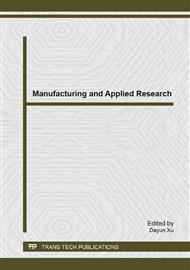[1]
Dj.M. Maric, P.F. Meier and S.K. Estreicher: Mater. Sci. Forum Vol. 83-87 (1992), p.119.
Google Scholar
[2]
Rezayar M. Knowledge-based Product Development Using XML and KCs[J]. Computer-Aided Design, 2000, 32(5): 299~309.
DOI: 10.1016/s0010-4485(00)00013-0
Google Scholar
[3]
Wei Jing, Zhang Guanghui, Li Fengji, Jiang Chunlai. Study on Parameter Optimization of Profile Curve Design on a Novel Differential Twin Screw Kneader[J]. China Mechanical Engineering, 2008, 19(7): 787~792.
Google Scholar
[4]
Qu Zhenzhen, Bao Heyun, Zhu Rupeng. Optimal design for parameter of high contact ratio planetary gears system[J]. Machinery Design & Manufacture, 2011, 12: 41~43.
Google Scholar
[5]
Chen Shenyan, Huang Hai. Structural optimization of spacecraft based on two-level multi-point approximate method[J]. Journal of Beijing University of A aeronautics and A astronautics, 2011, 37(2): 237~240.
Google Scholar
[6]
WU Dehui. A Prediction Model for Surface Roughness in Milling Based on Least Square Support Vector Machine [J]. China mechanical engineering, 2007, 18(7): 838~841.
Google Scholar
[7]
Qiao Peiyu, He Xin, Wei Zhonghui. Application of weighted total least squares in measurement of deflection angle with optical self-collimation method[J]. Optics and precision engineering, 2012, 20(9): 1953~(1959).
DOI: 10.3788/ope.20122009.1953
Google Scholar
[8]
Li Yongle, Liao Haili, Qiang Shizhong. identification for flutter derivatives of bridge deck cross section by weighting ensemble least- square method[J]. Journal of Civil Engineering, 2004, 37(3): 80~84.
Google Scholar
[9]
Zhang Xianfu, Feng Dongqin. Realization of Precise Time Synchronization Algorithm Based on Weighted Least-Squares Algorithm[J]. Chinese journal of sensors and actuators, 2008, 21(9): 1556~1560.
Google Scholar
[10]
Cao Zhengwen, Zhao Jian, Gao Baojian. The Research of Location About the Infrared Multi-sites System Based on the Weighted Least Square Method[J]. Acta PHOTONICA Sinica, 2005, 34(7): 1001~1004.
Google Scholar
[11]
Ma Jinfeng, Wang wei, Xu Youning, Wang Shuqun, Ding Yong, Chen Haigeng. calculation method for thermal efficiency of boilers based on the weighted least square principle[J]. Thermal power generation, 2011, 40(4): 45~47.
Google Scholar
[12]
Xie Jinbiao, Yao Weixing. Double Weighted Least Square Method for Fatigue S-N Curve Fitting[J]. Journal of Astronautics, 2010, 31(6): 1661~1665.
Google Scholar
[13]
China Heavy Machinery Industry Association. JB/ZQ4399-2006 welding type end through the sealing pipe threaded pipe joint[S]. KunMing: Yunnan Science and Technology Press, (2007).
Google Scholar
[14]
DIN. DIN/ISO 6020-1-2001 Mounting dimensions for single rod cylinders, 16 MPa (160 bar) series[S]. Germany : German Institute for Standardization, (2001).
DOI: 10.3403/bsiso6020
Google Scholar


